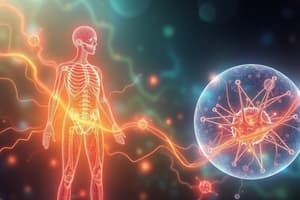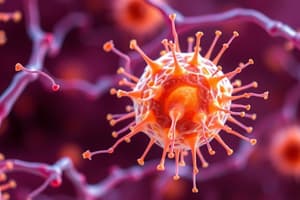Podcast
Questions and Answers
Which of the following is NOT a step in the general outline of signal transduction pathways for paracrine factors?
Which of the following is NOT a step in the general outline of signal transduction pathways for paracrine factors?
- Paracrine factor production and diffusion
- Series of enzymatic reactions
- Binding to a receptor
- TF activation or cytoskeleton regulation (correct)
Which region is NOT a component of a tyrosine kinase receptor?
Which region is NOT a component of a tyrosine kinase receptor?
- Cytoskeletal region (correct)
- Transmembrane region
- Extracellular region
- Cytoplasmic region
Which of the following is NOT a ligand of the RTK pathways?
Which of the following is NOT a ligand of the RTK pathways?
- IGF
- FGF
- EGF
- Stem cel (correct)
Which morphogen is responsible for skin development?
Which morphogen is responsible for skin development?
What does FGF8 secreted from developing neural retina induce?
What does FGF8 secreted from developing neural retina induce?
Which of the following is NOT a step in the general outline of signal transduction pathways for paracrine factors?
Which of the following is NOT a step in the general outline of signal transduction pathways for paracrine factors?
Which morphogen is responsible for blood vessel formation?
Which morphogen is responsible for blood vessel formation?
Which region is NOT a component of a tyrosine kinase receptor?
Which region is NOT a component of a tyrosine kinase receptor?
Which ligand is NOT associated with the RTK pathways?
Which ligand is NOT associated with the RTK pathways?
What is the role of FGF8 secreted from developing neural retina?
What is the role of FGF8 secreted from developing neural retina?
Flashcards are hidden until you start studying
Study Notes
Overview of Paracrine Factor Signaling Pathways
- Paracrine factors are morphogens or ligands that bind to receptors.
- Paracrine factors can activate a series of enzymatic reactions or regulate cytoskeleton, leading to TF activation or cell shape/migration responses.
- Receptor tyrosine kinases (RTKs) are involved in paracrine factor signaling.
- RTKs have extracellular, transmembrane, and cytoplasmic regions.
- Paracrine factors from the FGF family play a crucial role in signal transduction pathways.
- FGF-RTK pathways are involved in various biological processes, such as eye development, vulva formation, and cancer progression.
- Specific members of the FGF family have distinct functions, such as FGF1 in regeneration, FGF2 in blood vessel formation, FGF7 in skin development, and FGF8 in lens induction and limb development.
- FGF8 is secreted from the developing neural retina and induces the formation of the lens.
- RTK signal transduction pathway is widely used in various biological processes.
- Ligands of RTK pathways include FGF, EGF, IGF, and stem cells.
- Paracrine factors are produced and diffuse, then bind to their receptors.
- This binding leads to conformational changes in the receptor and activation of enzymatic activity (kinase), which can further activate TFs or cytoskeletal proteins.
Studying That Suits You
Use AI to generate personalized quizzes and flashcards to suit your learning preferences.




